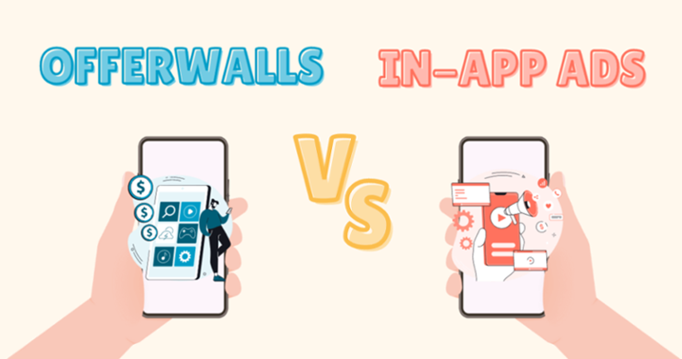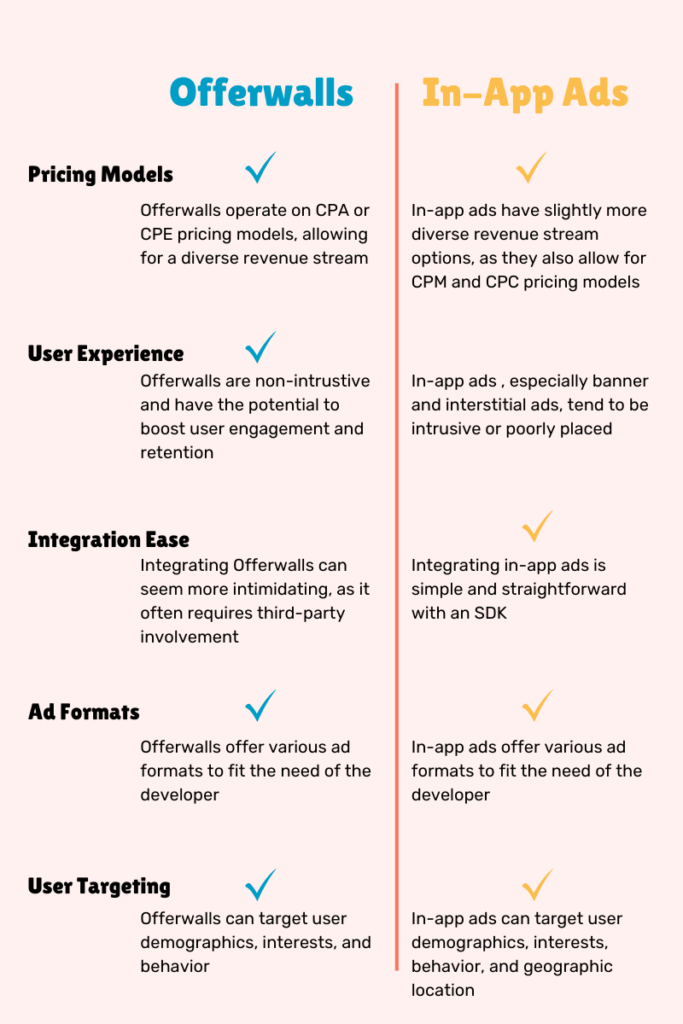
Introduction
There are several decisions that developers must face when deciding the most effective mobile app monetization strategy to generate revenue. One such decision involves the type of advertisement to integrate.
Two popular choices are Offerwalls and in-app advertising. To choose between them, developers must weigh each option’s advantages and disadvantages before implementation.
In this article, we’ll delve into the features and nuances of each approach to help developers make informed decisions about their mobile app monetization strategy.
Table of Contents
Offerwalls
Our first option, Offerwalls, is a monetization tool compatible with mobile application and website integration. With it, developers can present users with advertising offers, surveys, or interactive tasks in exchange for in-app rewards, virtual currency, or premium content.
Through in-app integration, an Offerwall appears as a dedicated section or overlay. Users can engage with the Offerwall offers that interest them in return for a desired reward.
The following points help you decide if an Offerwall is the right option for your mobile app monetization strategy.
Which Pricing Models Are Possible?
Offerwalls operate on cost-per-action (CPA) or cost-per-engagement (CPE) pricing models, where developers earn revenue when users complete specific actions or interactions within the app.
Some actions include downloading other apps, completing surveys, or making in-app purchases. This model provides developers with a diversified revenue stream beyond traditional in-app purchases.
Earnings, however, can vary depending on user engagement and the quality of offers available.
How Does It Impact User Experience?
Offerwalls can be much more effective than traditional ads in boosting user engagement and creating a better user experience. They’re non-intrusive and offer users more control over their experience, which leads to higher engagement rates.
Additionally, developers can keep users actively engaged within the app for longer by offering rewards or incentives for completing actions.
This increased engagement can lead to higher retention rates and revenue potential. When Offerwalls are combined with another monetization model, the user retention rate is 50% higher!
How Complex Is Its Integration?
At first, implementing an Offerwall can initially seem more complex or intimidating than other monetization methods. It typically involves integrating with third-party ad networks or platforms that provide Offerwall services.
However, when done right, Offerwalls can be customized to fit seamlessly into an app’s user journey and integrate easily. Many ad networks offer comprehensive SDKs and documentation to streamline the integration process.
Which Ad Formats Are Available?
Offerwalls typically offer a variety of ad formats to choose from, allowing for a more personalized ad approach that fits into each app type.
The traditional in-app Offerwall typically offers a mix of surveys, downloadable apps, and video ads. Developers can also choose a video-only Offerwall or any other format that integrates best into their app environment.
This flexibility allows developers to tailor the Offerwall experience to suit their app’s design and user experience.
Are There Options For User Personalization?
Offerwalls often provide robust targeting and personalization options. They allow developers to tailor the presented offers based on the user’s demographics, interests, and past behavior.
In addition to tailoring the offers to users based on their profile, Offerwalls present users with various tasks so that they can choose how they earn their reward.
This level of customization helps ensure that the Offerwall presents users with relevant and engaging offers.
In-App Advertising
With our second option, in-app advertising, app developers sell ad space within the mobile app for one ad at a time. Common types of in-app advertising include banner ads, interstitial ads, video ads, and native ads.
The following points help you decide if in-app advertising is the right option for your mobile app monetization strategy.
Which Pricing Models Are Possible?
In-app advertising operates on various pricing models, including cost-per-click (CPC), cost-per-mille (CPM), and cost-per-action (CPA). Developers earn revenue when users engage with or view ads displayed within the app. This choice of pricing models offers a straightforward way to monetize app traffic and can generate significant revenue when implemented effectively.
However, depending solely on in-app advertising for revenue may not be sufficient for some apps – especially those with niche or limited user bases.
How Does It Impact User Experience?
While in-app advertising can provide steady revenue, developers must understand their users and balance ad placement to avoid disrupting the user experience.
Traditional in-app ads can be intrusive, irrelevant, or poorly placed — all of which negatively impact user experience and drive users away from the app. Additionally, these ads are limited to their format, which results in the user ignoring, closing, or even blocking the ad if not properly optimized for the user.
However, when implemented thoughtfully, in-app advertising can enhance user engagement by providing relevant and timely ad experiences.
Developers can increase revenue while maintaining a positive user experience by optimizing the placement and frequency of in-app ads.
How Complex Is Its Integration?
Integrating in-app advertising SDKs is generally straightforward, and many ad networks offer SDKs that support multiple ad formats and platforms.
This ease of integration makes it accessible to developers of all skill levels and reduces the time and effort required to implement in-app advertising within an app.
Which Ad Formats Are Available?
In-app advertising offers a range of traditional ad formats, including banners, interstitials, and native ads.
Some formats, such as banner and interstitial ads, are more intrusive. Banner ads appear at the top or bottom of the app screen at any time of usage, and interstitial ads are full-screen ads that appear at natural pause points during app usage.
Native ads match the look and feel of the app, making them a bit less intrusive for users.
Diversity in ad format allows developers to choose the format(s) that best fit their app’s design and user experience. However, developers must consider their app environment when integrating in-app advertisements to avoid negative user perceptions.
Are There Options For User Personalization?
Similar to Offerwalls, in-app advertising platforms offer sophisticated targeting and personalization capabilities.
Developers can target ads based on user demographics, interests, behavior, and geographic location, delivering more relevant and engaging ad experiences to users.
Pros and Cons
Offerwalls:
Some pros for Offerwalls include the potential for high user engagement, ad format flexibility, and improved user targeting and personalization options.
On the other hand, developers might experience difficulty in implementing an Offerwall without a provider.
In-App Advertising:
Choosing In-App advertising includes pros such as integration ease, various monetization models, and sophisticated targeting and personalization options.
However, developers that use in-app advertising might risk disrupting user experience and experience difficulty in balancing revenue generation with user satisfaction.

In Conclusion
In conclusion, Offerwalls and in-app advertising offer viable options for monetizing mobile apps. The choice between the two depends on various characteristics, such as app design, user demographics, and revenue goals.
Developers should carefully evaluate the pros and cons of each approach and consider experimenting with different monetization strategies to find the optimal solution for their app.
If 2024 is the year you are developing or reevaluating your mobile app monetization strategy, consider the following:
- Offerwalls might be the best choice if user experience and engagement are top priorities for your app monetization strategy
- In-app advertisements might be the best choice if ease of integration is a top priority for your app monetization strategy
- Developers can effectively target and personalize their ads for users with both options if the ads are integrated with optimization in mind
Are you interested in integrating an Offerwall solution into your mobile app monetization strategy? Smatched can help with the customization and integration of an Offerwall solution that fits your app! Check out why Smatched might be the best choice for you on our website.


